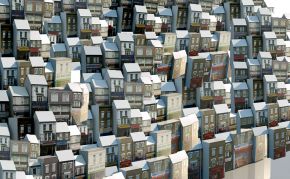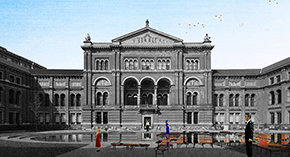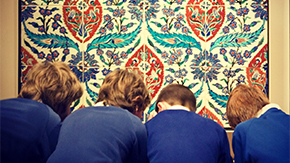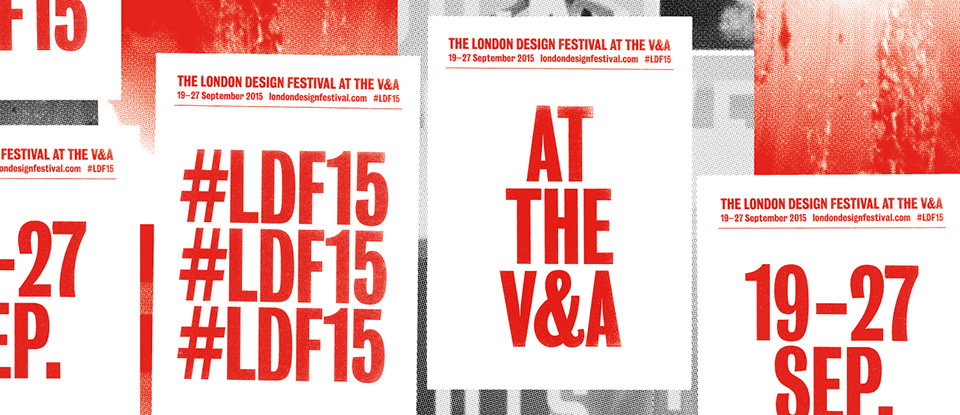London Design Festival at the V&A 2015: Installations and Displays

Artist's impression of a section of the tower, (c) Barnaby Barford
Barnaby Barford: The Tower of Babel
Gallery 50a (map)
8 September – 1 November 2015
A major sculptural installation created for the V&A by artist Barnaby Barford, The Tower of Babel tells an array of stories about our capital city, our society and economy, and ourselves as consumers. Standing an imposing six metres high, the Tower comprises 3000 bone china shops, each one unique, each depicting a real London shop photographed by the artist. At its base the shops are derelict, while at its pinnacle are the crème-de-la-crème of London’s exclusive boutiques and galleries.
Standing as a monument to the great
British pastime of shopping, Barford’s apparently precarious Tower
playfully likens our efforts to find fulfilment through retail with the
biblical Tower of Babel’s attempt to reach heaven. Explicitly blurring
the boundaries of art and commerce, each shop in the Tower will be for
sale during its exhibition. With more prestigious but less affordable
properties higher in the Tower, Barford confronts us with the choices we
ourselves make as consumers, through necessity or desire.

Curiosity Cloud by mischer'traxler
Curiosity Cloud
Britain 1500-1760, Room 52b, Level 2 (map)
19 – 27 September
Free, drop in
Inspired by the Art Nouveau Movement, renowned Austrian design duo mischer’traxler bring a sensual, interactive installation to the V&A’s Norfolk House Music Room.
The installation comprises 250 mouth-blown glass globes made by the Viennese glass company Lobmeyr. Each globe contains a single hand-fabricated insect and each insect has been printed onto foil, which has been laser cut and then hand embroidered to create the body. Capturing the full range of human engagement with this natural order, 25 insect species are represented, falling into three categories: extinct, common, and newly discovered. This new project developed for London Design Festival, takes its cues from Perrier-Jouët’s connection to the Art Nouveau movement, and the traditional use of insect motifs throughout this period.
From a distance, the insects are quiet and calm. A scattered few across the installation move, their vessels emitting a soft, glowing light. As visitors enter the darkened room and approach the installation, the insects come to life – moving more rapidly and emitting trilling noises as they collide with the glass in which they are encapsulated.
Supported by Champagne Perrier-Jouët

Paysages Désertiques by ECA Josefina Munoz with Swiss craftsman Peter Fink. Partnership with Vacheron Constantin. Picture by Jonas Margu
Dialogues in Design & Craftsmanship
Fashion, Room 40, Level 1 (map)
September 18 – 27
Free, drop in
How will luxury be made in the future? What are the skills and how can they be taught? The renowned Swiss school ECAL/University of Art and Design Lausanne collaborates with craftsmen of traditional luxury brands – such as Vacheron Constantin, Hermès, Baccarat or Christofle – to achieve exceptional work based on expertise, investment and skills. This display showcases recent work by students of the Master of Advanced Studies in Design for Luxury and Craftsmanship.

Heavy Space Utilisation by Matthew Raw and Thom Swann
Heavy Space Utilisation
Medieval & Renaissance, The Parasol Foundation Trust Study Area, Room 10b, Level 0 (map)
19 – 27 September
Free, drop in
Former V&A artists-in-residence Matthew Raw and Thom Swann create a contemporary typographic mosaic that challenges the uncreative managerialism rife in current arts education policy. The piece will be exhibited in an original V&A ‘Valhalla’ frame and made at Studio Manifold and J W Restorations.

Mise-en-abyme by Laetitia de Allegri and Matteo Fogale
Mise-en-abyme
Bridge next to Glass Lift O, Level 3 (map)
19-27 September
Free, drop in
Designers Laetitia de Allegri and Matteo Fogale have collaborated with Johnson Tiles to create Mise-en-abyme, a colourful and immersive installation for Gallery 112, the bridge over the Medieval and Renaissance galleries.
Fascinated by the discovery of one-point perspective during the Renaissance period, the duo have created a landscape of overlapping semi-transparent shapes that plays with the viewers sense of perspective. The title of the work is a French term that literally translates as “placed into abyss”, and refers to the experience of walking through the installation.
The grout lines of the tiles lining the bridge represent the perspective grid lines found on Renaissance drawings, creating an illusion of exaggerated depth that draws the viewer into the work. Each tile features a custom pattern of gradating colour that makes the landscape across the bridge appear to open outward or to close inward, depending on the visitor’s point of view.
Supported by Johnson Tiles

Royal Festival Hall Lounge Chair (1951) Robin Day designed all the seating for the Royal Festival Hall, the first major new modern building after the War. Photo: Mark Whitfield. Copyright: twentytwentyone
Robin Day Works in Wood
Landing, Britain 1500-1760, Level 4 (map)
19-27 September
Free, drop in
It isn’t an exaggeration to say that Robin Day is one of the most significant furniture designers of the 20th century. There aren’t many people who haven’t sat on one of his designs. To mark the centenary of Day’s birth, this display celebrates his life and marks the huge contribution his work has made to our everyday lives.
Although best known for his polypropylene stacking chair, Day was hugely influenced by the forests of his childhood and the display focuses on Day’s passionate interest in and relationship with wood.
The display is curated by Jane Withers and designed by Turner Prize nominees Assemble.
Supported by Robin and Lucienne Day Foundation

The Cloakroom by Faye Toogood
The Cloakroom
Britain 1500-1760, The Clore Study Area, Room 55, Level 2 (map)
19-27 September
Free, drop in
Visitors to the V&A during the London Design Festival will be transformed into temporary custodians via Faye Toogood’s two-part installation, The Cloakroom. The first part of the experience is a literal cloakroom, located in Gallery 55, where visitors are invited to checkout one of 150 Toogood coats to wear around the Museum. Each coat is equipped with a sewn-in map that guides the visitor through the second part of the installation: ten places in the Museum galleries, where they will discover a series of sculptural garments created by Toogood in response to nearby objects from the Museum’s collection – from a 15th century timber-panelled room to a shining suit of armour.
Please note that a security deposit (photo ID / credit card) will be required to check out a coat.
Please allow an hour to complete the journey through the Museum.

The Ogham Wall by Grafton Architects
The Ogham Wall
Tapestries, Room 94, Level 3 (map)
19 – 27 September
Created by Stirling Prize nominee Grafton Architects, in conjunction with Graphic Relief, The Ogham Wall is inspired by the Irish Ogham alphabet, dating from the 4th century AD. As a basis for exploring the ancient and the contemporary, the installation translates this ancient language into an architectural construct of three metre high cast concrete ‘fins’ standing in the space of the Tapestry Gallery. Each of the 20 letters represents the name of a sacred tree, where the individual pattern of the bark is etched onto the surface treatment of the concrete.
Metals such as bronze, brass and nickel are combined to create rich, tactile surfaces that will change in texture, temperature and colour. Visitors are invited to move within the spaces formed by the new structures, to enjoy the varied rhythm and angles of the elements and the experience of light and shade. The installation aims to explore the space that Ireland occupies, one that is embracing design, innovation and technology while continuing to reference their embedded culture and heritage.
Created in collaboration with Irish Design 2015 (ID2015), a year-long initiative backed by the Irish government promoting and celebrating the talent behind Irish design in the island’s first ever global design showcase.

Three Vessels, 2015. Image © Phil Goss
Three Vessels, 2015
Sculpture, The Dorothy and Michael Hintze Galleries Room 22, Level 1 (map)
19 – 27 September
Free, drop in
Three handmade vessels, created by multidisciplinary design team Phil Goss (illustrator), Amy Hughes (ceramicist) and Jamie Jenkinson (video artist). Each contains hidden imagery, influenced by the form and décor of the vessels themselves, but only visible when viewed through the lens of a camera phone.

Tryst by Amy Hughes
Tryst
Ceramics, The Timothy Sainsbury Gallery, Room 143,
Level 6 (map)
17 September – 2 October
Free, drop in
The vase is a symbol of the ancient world, a functional object and a design motif; this collection aims to restore its former status as the Ultimate Accessory.
In this collaborative project between ceramicist Amy Jayne Hughes, the V&A and 1882 Ltd, industry meets the studio maker – a meeting head on of two contrasting realms of making.
As part of her Residency at the V&A, Amy explored how stages and conditions of manufacture can be controlled to create variety in the final product. Taking inspiration from the Museum's Collections, Amy uses elements of her own practice to marry traditional hand decorating techniques with the skills and expertise of Stoke on Trent's finest industry, with harmonious consequence.
The vase takes direct inspiration from early and mid-18th Century Porcelain wares, with a desire to make such objects more accessible, taking them to new audiences, deconstructing and reworking to appeal to today’s consumer. The decoration, taken from sprig moulds carefully cast from Museum objects, hints at and pays homage to the originals whilst finding a new place in contemporary culture.
Designed in London, produced
in Stoke, each slip cast fine bone china vase is unique in its
finishing, organic rim and painterly splashes, worked with a knowledge
of material and history of the subject.
Amy
Hughes is the V&A Ceramics Artist
in Residence, 2 May – 23 September 2015.
This
Residency is supported by the William Brake Charitable Trust.
In collaboration with 1882 Ltd.

Rare earthenware, Unknown Fields Division © Toby Smith
V&A Design Fund 2015
Medieval and Renaissance, The Simon Sainsbury Gallery, Room 64b, Level 1 (map)
18 September – 18 October
Free, drop in
The Victoria and Albert Museum’s contemporary collection is constantly evolving. It reflects and represents transformations in design and art as much as in society. Supporters of the Design Fund have enabled the V&A to continue to acquire objects at the vanguard of contemporary design.
The latest selection of acquisitions encompasses works by both national and international designers, artists and architects. They include Dutch designer Marten Baas’ Plastic Chair in Wood commissioned by Pearl Lam Gallery (Shanghai). Hand crafted by Chinese woodcarvers, the elmwood chair’s form is taken from the ubiquitous Monobloc chair. The display also features a series of photographs by Trevor Paglen of US intelligence agencies. Paglen’s work aims to reveal the physical evidence of the immaterial world of surveillance and espionage.
The Museum is also delighted to be able to acquire Rare Earthenware, a project by Unknown Fields Division commissioned for the exhibition ‘What is Luxury?’. The project retraces the global supply chain of the rare earth elements widely used in consumer electronics, thus questioning our relationships with demand and necessity, pollution and value.

V&A Dundee, night shot. Image © KKAA / Design Dundee Ltd
Architecture Now: V&A Museum of Design Dundee
Landing, Architecture, Staircase P, level 4 (map)
19 September 2015 – Spring 2016
Free, drop in
Find out more about V&A Dundee through this display. Due to open in 2018, V&A Dundee will be the first-ever dedicated design museum for Scotland. A place of inspiration, fun and learning, we are creating a world-class attraction.
The building, itself an example of cutting-edge innovation, is renowned architect KengoKuma’s first in the UK.

You Know, You Cannot See Yourself So Well as by Reflection
You Know, You Cannot See Yourself So Well as by Reflection
John Madejski Garden (map)
26 May – 3 October
Welcome to the V&A’s summer pavilion, created for the London Design Festival at the V&A by Mexican architect Frida Escobedo to celebrate the Year of Mexico in the UK.
The temporary structure overlaps two very different landscapes and aims to spark discussions about identity and cultural exchange.
The pavilion is inspired by Tenochtitlán, the ancient Aztec city that was built on a lake. Referencing the multicultural influences that coexist in contemporary Mexico, the pavilion is a flexible space made up of layers of reflective surfaces that can be moved and adapted to hold a wide variety of events and activities.
A V&A and London Design Festival project, with support from the government of Mexico.

Zotem by Kim Thomé
Zotem
Grand Entrance and Ceramics, The McAulay Gallery, Room141, Level 6 (map)
19 September – 31 October
Free, drop in
During the Festival, visitors to the V&A will be greeted by Zotem, a bold and colourful installation conceived by London-based Norwegian designer Kim Thomé. Created in collaboration with Swarovski, Zotem is an 18-metre-tall double-sided monolith embedded with over-sized Swarovski crystals, which rises vertically from the Museum’s Grand Entrance to the Contemporary Ceramics gallery directly above it, on the sixth floor.
The installation comprises 640 custom-made Swarovski crystals scaled up to 2½ times their regular size and displayed in a grid pattern within a frame of matte black aluminium. A roll of vividly printed mesh runs in a continuous loop inside the two aluminium faces – moving up one side and down the other. As light shines through the graphic mesh and the crystals, the pattern and colour is projected and distorted, creating an ephemeral and dynamic effect that brings the crystal to life and draws the eye upward. At the top of the structure – which can be viewed from the Ceramics – the crystal grid pattern fans out in a crescendo of colour and light.
Supported by Swarovski
Contents
- Exhibition Home
- About the London Design Festival 2015
- London Design Festival at the V&A 2015: Installations and Displays
- Videos: London Design Festival at the V&A 2015 - Meet the Designers
- London Design Festival at the V&A 2015: Highlights
- 'You Know, You Cannot See Yourself So Well as by reflection
- Barnaby Barford: The Tower of Babel
- The London Design Festival at the V&A
International Training Course

The Victoria and Albert Museum welcomes applications for ‘Creating Innovative Learning Programmes’, its new one week intensive course. This is a unique training opportunity for museum professionals from overseas who are interested in attracting and programming for a range of museum audiences.
Find out more